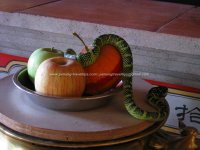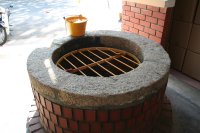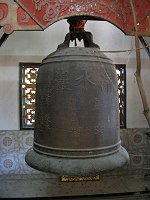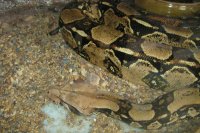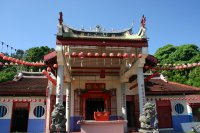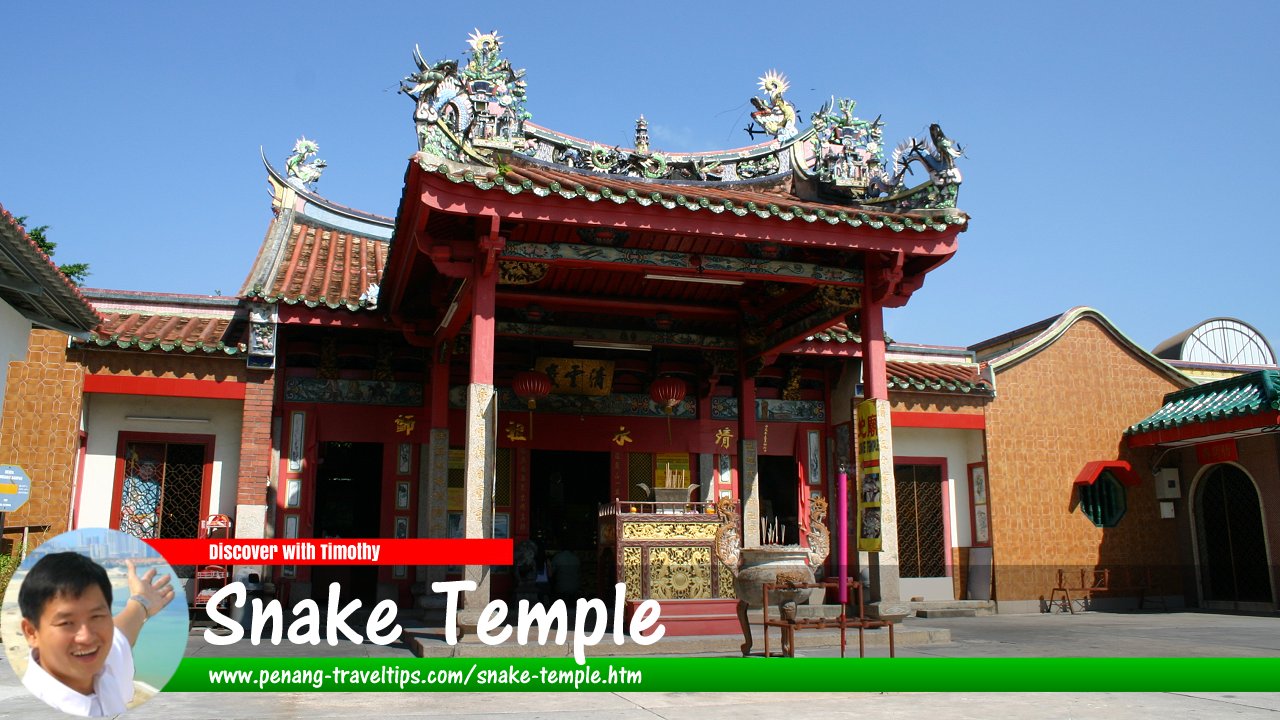 Snake Temple (10 June 2006)
Snake Temple (10 June 2006)
The Snake Temple (GPS: 5.31419, 100.28524) (TC: 望腳蘭福興宮蛇廟, SC: 望脚兰福兴宫蛇庙, PY: Wàng jiǎo lán fú xìnggōng shé miào, Penang Hokkien Taiji: Bang33 Kha3 Lan2 Hock1 Hin3 Keong1 Cua3beo33) is a famous Chinese temple in Penang. It is located in Sungai Keluang (TC: 望腳蘭, SC: 望脚兰, Taiji: Bang33 Kha3 Lan2), formerly a settlement within Bayan Lepas. The official name of the temple is Hock Hin Keong (TC: 福興宮, SC: 福兴宫, PY: Fú xìnggōng, Taiji: Hock1 Hin3 Keong1), though it is better known colloquially as Penang Hokkien as Bang33 Kha3 Lan2 Cua3beo33
 (望腳蘭蛇廟) and in Mandarin as Shé Miào (蛇庙). In English, the temple is often called Temple of the Azure Clouds even though Hock Hin Keong translates as Palace of Abundant Prosperity.
(望腳蘭蛇廟) and in Mandarin as Shé Miào (蛇庙). In English, the temple is often called Temple of the Azure Clouds even though Hock Hin Keong translates as Palace of Abundant Prosperity.The Snake Temple is otherwise no different from other Chinese temples in Penang, if not for its resident snakes. The temple is home to live poisonous Wagker's Pit Vipers, and because of this temple, this type of snake is now also called temple pit vipers.
The temple is such an important attraction for Penang that it could not be shifted when the Bayan Lepas Main Road was realigned, creating the present-day Jalan Sultan Azlan Shah. That remnant portion of the old Bayan Lepas Main Road is now known as Jalan Tokong Ular, named after the temple.
History of the Snake Temple
The Snake Temple was built in 1805 to venerate a deified Buddhist monk named Chor Soo Kong (祖師公), the Hokkien name for Cheng Swee Chor Soo (or in Mandarin, Qīngshuǐ zǔshī, 清水祖师). It occupies Lot 496 of Mukim 12 in the Penang South West District, under the State Grant 855 dating to 1st July 1803. In Cantonese, Chor Soo Kong is called Chou See Yeah. "Chor Soo" is in fact an honorific title for an eminent historic figure who is to be continuously revered by subsequent generations. Chor Soo Kong and Chou See Yeah means the same thing: "The Much Honoured Chor Soo".There are in fact three temples dedicated to Chor Soo Kong in Penang. Apart from the famous Snake Temple, the other two are the Chor Soo Kong Temple in Batu Maung and another in Balik Pulau. However, only the temple in Sungai Keluang plays host to slittery residents.
The location of the Snake Temple is Sungai Keluang, also known in Penang Hokkien as Bang33 Kha3 Lan2 (望腳蘭). In English, the temple is often known as Temple of the Azure Clouds. Every year, pilgrims come from far and near on Chor Soo Kong's birthday, which falls on the 6th day of the first lunar month, hence it's a traditional temple to visit during Chinese New Year.
Chor Soo Kong was born in Fujian province during the Song Dynasty (960-1276 AD), during the reign of Emperor Ren-Zong (1023-1063 AD). He is from the "Tan" clan and his personal name was "Eng". He entered monkhood from an early age. Upon his ordination, he received the Buddhist name Pu-Zu. He started his life as a monk by staying at a monastery called Da Yun Yuan. Later on, he decided to lead an ascetic life in Gao-Tai Mountain, to strive for spiritual cultivation. Through the guidance of Zen Master Ming-Song, Chor Soo Kong attained spiritual enlightenment.
In addition to spiritual enlightenment, Chor Soo Kong acquired extensive medical knowledge, enabling him to provide medical services to the needy in the surrounding communities.
On the sixth year of the reign of Emperor Shen-Zhong of the Song Dynasty (corresponding to around the year 1073 AD), the area of Qing-Xi in Fujian suffered a terrible drought. When Chor Soo Kong went there and prayed for rain, and the rain came. In gratitude, the people built a monastery for him on Peng-Lai Mountain. Chor Soo Kong called the monastery Cheng3 Swee1 Giam2 (清水岩), which means, The Rock of Clear Water. From this name, when Chor Soo Kong was deified, the Snake Temple became known as Cheng3 Swee1 Keong1, literally meaning "Palace of Clear Water."
In 1805, a monk arrived from China, bringing with him the statue of Chor Soo Kong. The monk then built a temple dedicated to Chor Soo Kong in a clearing by the Sungai Keluang river in Bayan Lepas. The area belonged to David Brown, the largest land owner in Penang. Brown donated the land for the temple after he was healed of an ailment. At that time, the surrounding area was jungle, and there was plenty of snakes. After the temple was erected, snakes particularly pit vipers started coming to take shelter there, inhabited various parts of the temple. Rather than harming the snakes, the pious monk provided shelter to them.
The Snake Temple is  on the Map of Sungai Keluang
on the Map of Sungai Keluang
 Sights within the Snake Temple
Sights within the Snake Temple
In addition to the main Prayer Hall, the following are some of the sights at the Snake Temple: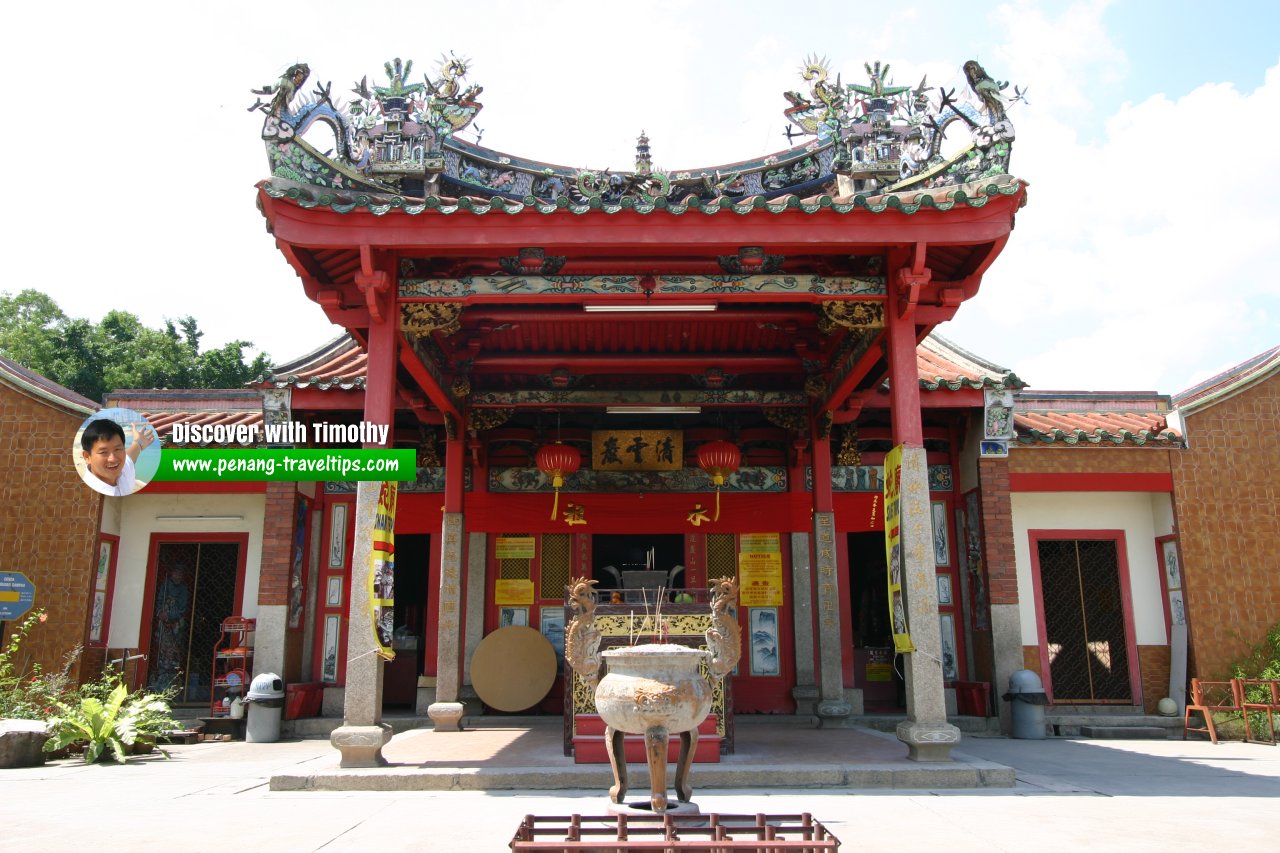 Snake Temple front façade (28 January 2006)
Snake Temple front façade (28 January 2006)
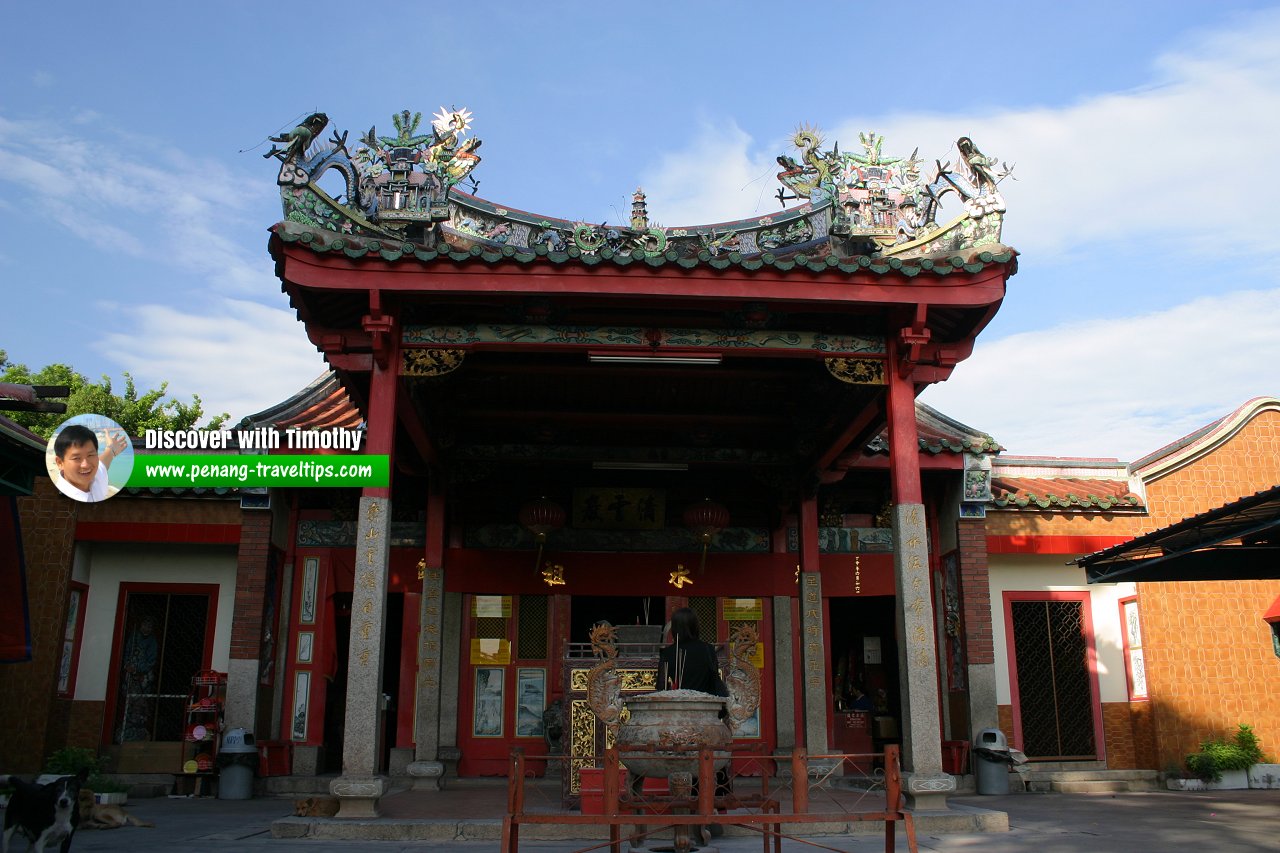 Snake Temple, Penang (3 January 2005)
Snake Temple, Penang (3 January 2005)
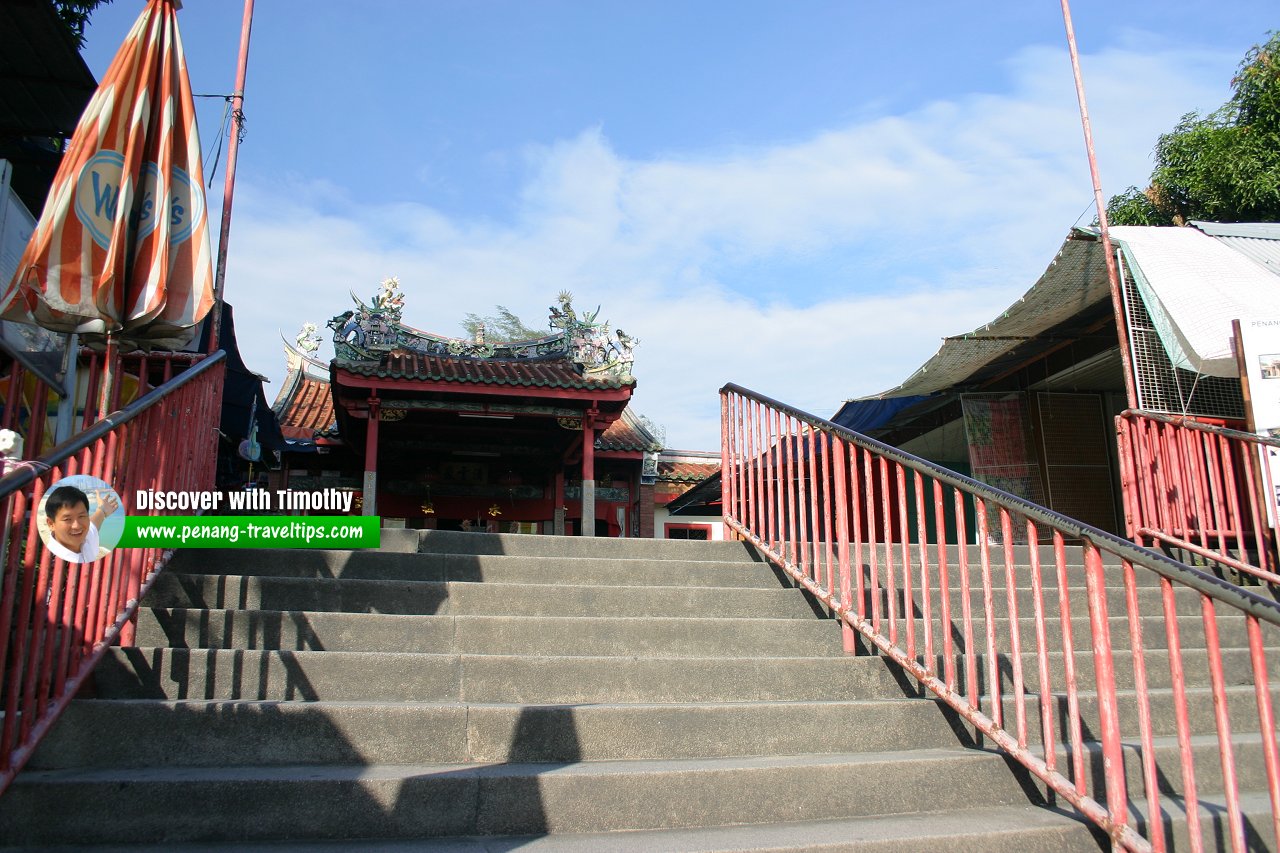 Staircase leading up to the Snake Temple (3 January 2005)
Staircase leading up to the Snake Temple (3 January 2005)
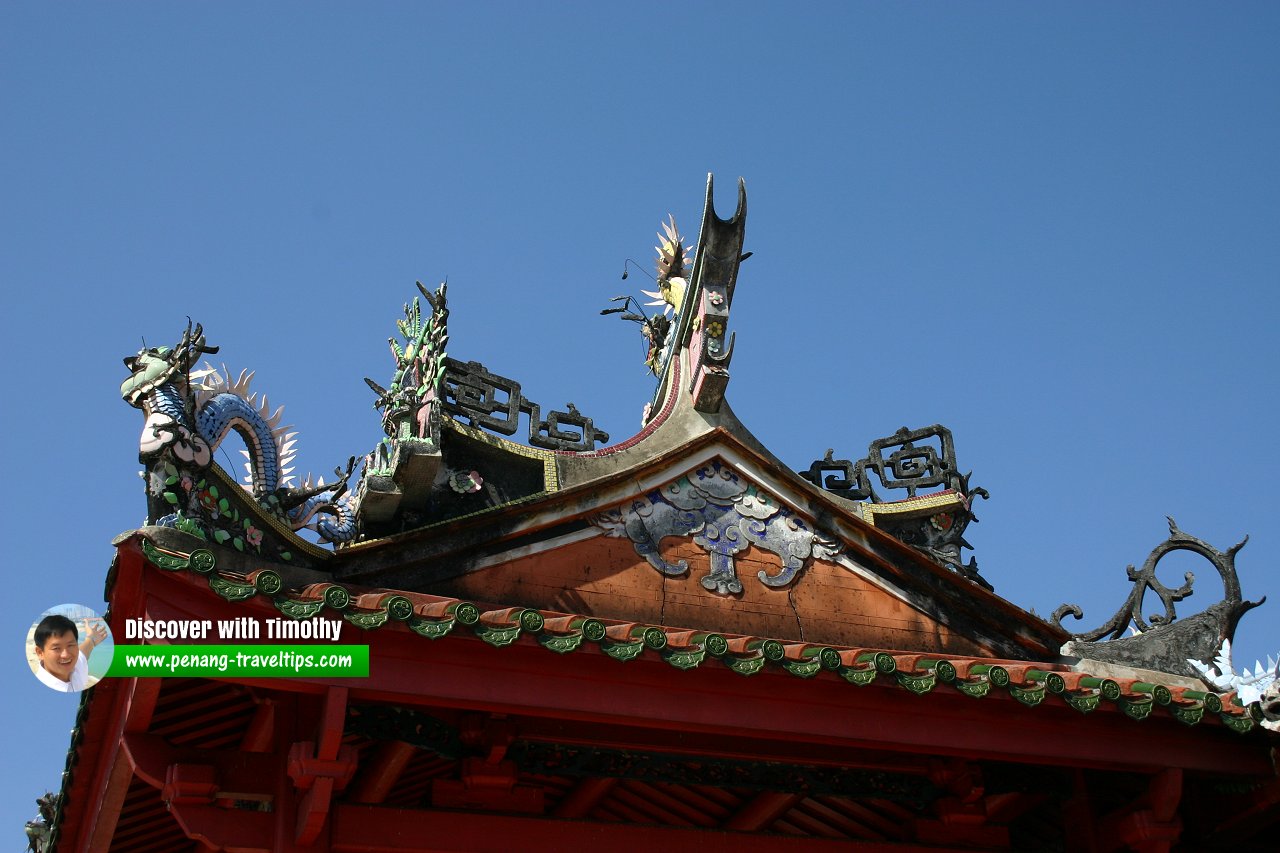 Snake Temple, roof details (10 June 2006)
Snake Temple, roof details (10 June 2006)
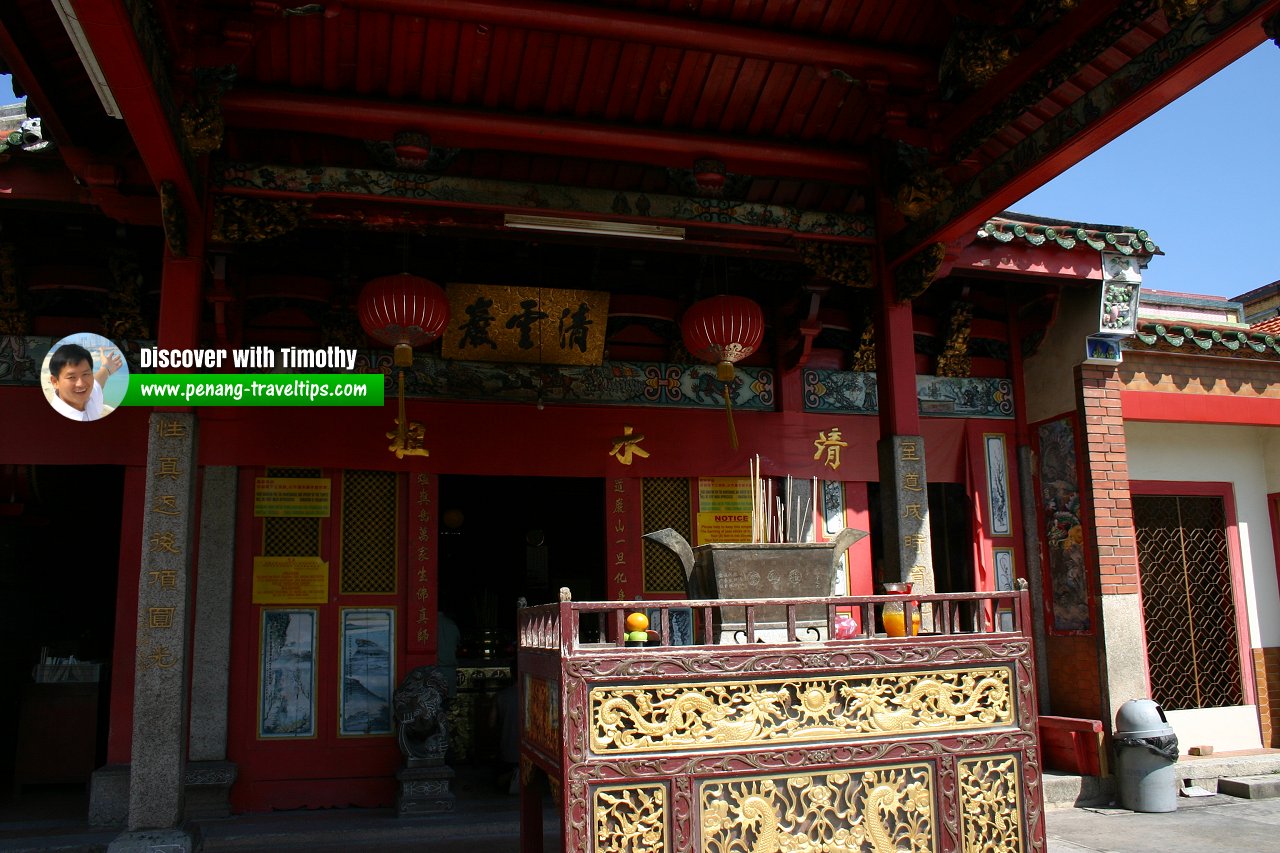 Front porch of the Snake Temple (10 June 2006)
Front porch of the Snake Temple (10 June 2006)
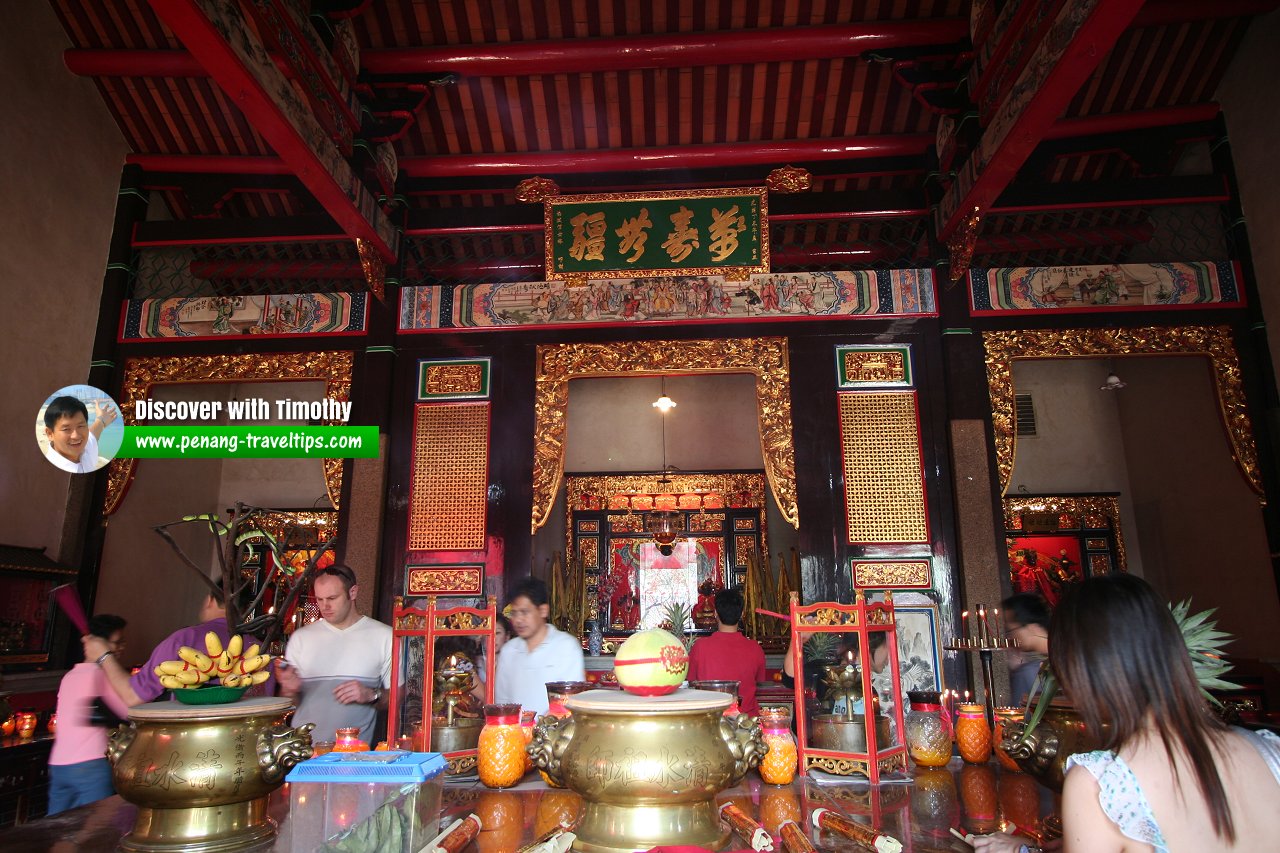 The prayer hall of the Snake Temple (28 January 2009)
The prayer hall of the Snake Temple (28 January 2009)
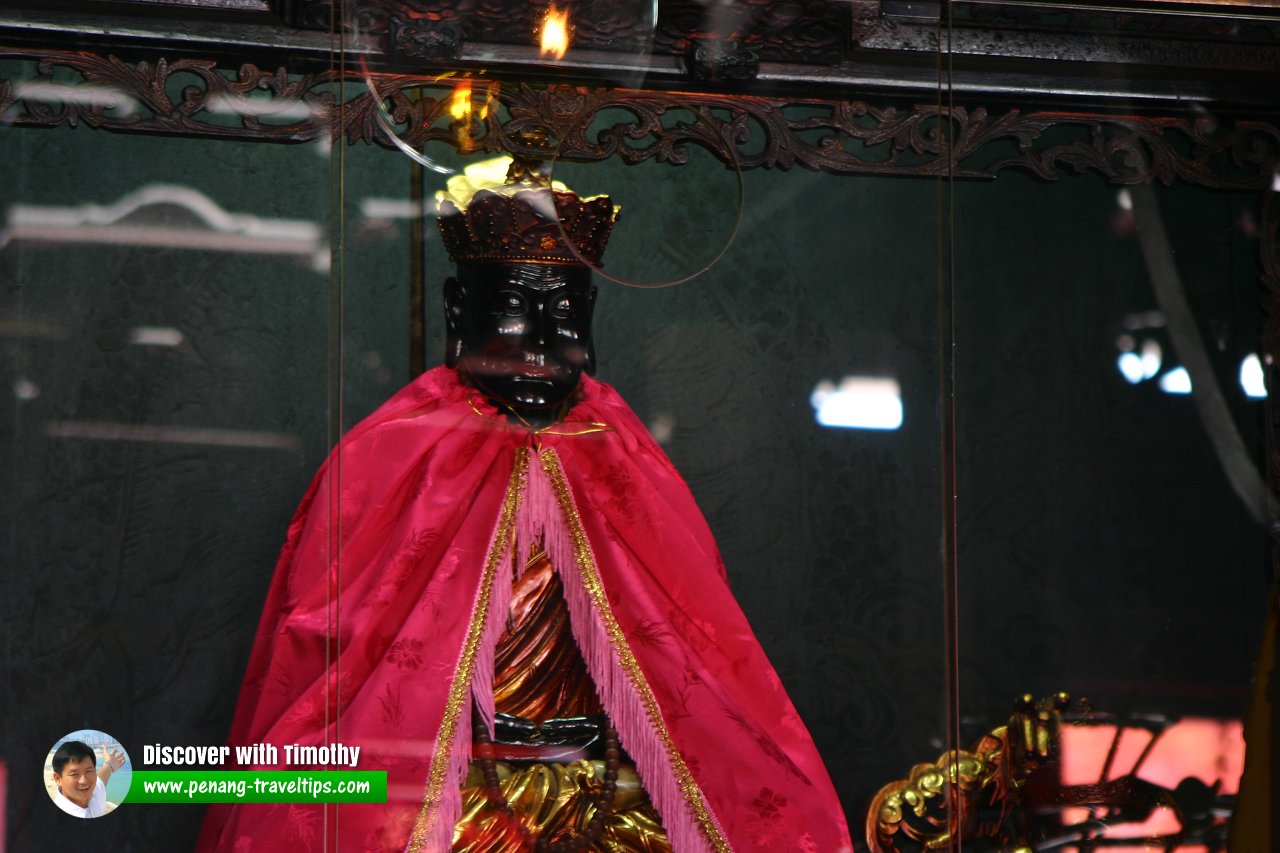 Image of Chor Soo Kong (清水祖师), the principal deity of the Snake Temple (28 January 2006)
Image of Chor Soo Kong (清水祖师), the principal deity of the Snake Temple (28 January 2006)
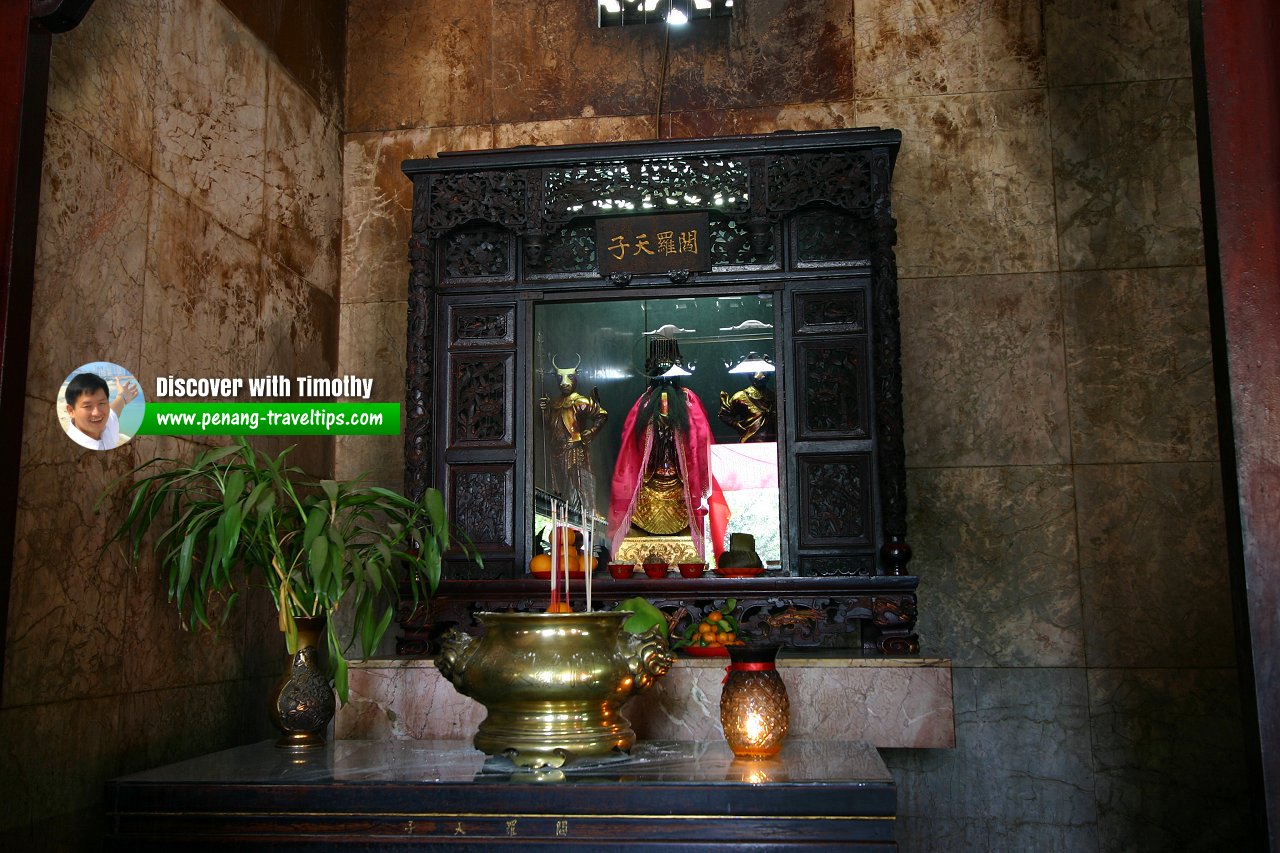 Left alcove of the Snake Temple, with altar to Yan Luo Tian Zu (阎罗天子), the Underworld Emperor (28 January 2006)
Left alcove of the Snake Temple, with altar to Yan Luo Tian Zu (阎罗天子), the Underworld Emperor (28 January 2006)
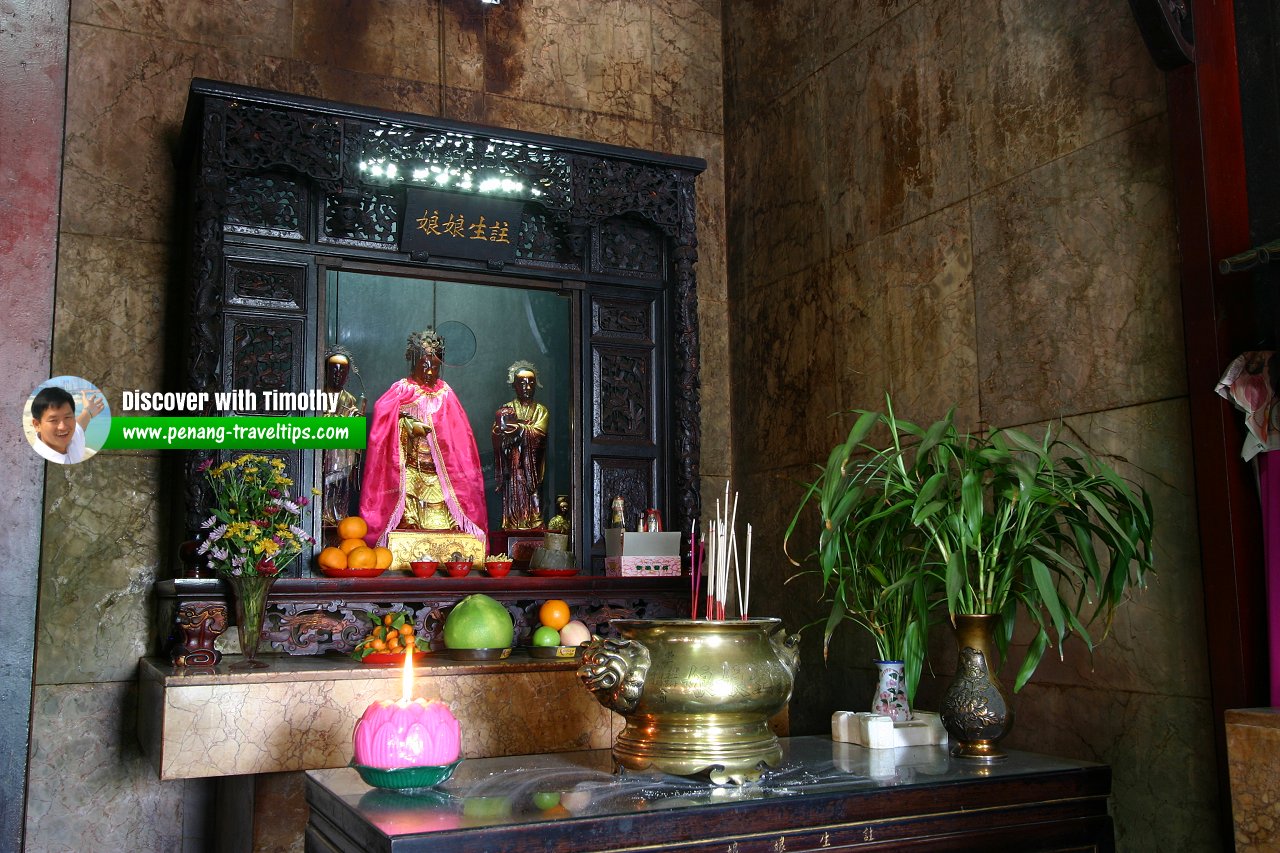 Right alcove, with altar to Songzi Niangniang (送子娘娘), also called Zhusheng Niangniang (註生娘娘), the Taoist goddess of fertility (28 January 2006)
Right alcove, with altar to Songzi Niangniang (送子娘娘), also called Zhusheng Niangniang (註生娘娘), the Taoist goddess of fertility (28 January 2006)
WARNING
There are photographs of the snakes in the temple below. If you are squeamish about viewing snakes, do not scroll any further.
The snakes of the Snake Temple
The snakes of the Snake Temple were the poisonous Wagler's Pit Vipers, also called the Temple Pit Vipers, or in Malay, ular kapak tokong. They are fond of inhabiting coconut trees. Their range is from South Thailand to Peninsular Malaysia, Borneo, Sumatra, Sulawesi and the southern island of the Philippines archipelago. They can grow to 1 - 1.3 meters long (3-4 ft). When young, they are light green with narrow pale bands. On reaching adulthood, the snakes take on a darker green with thicker yellow bands. Although the poison is not very dangerous, the bite can be very painful and can cause much swelling. However the snakes are usually sluggish and seldom bite.Continuous development of the surrounding areas in Bayan Lepas has today enveloped the Snake Temple, resulting in a loss of habitat for the snakes, and a general reduction in their numbers. The jungle behind the temple has long disappeared, and it is now part of the Bayan Lepas Industrial Zone housing various multinational corporations.
Contrary to popular belief, the vipers were not attracted to the smoke of the temple. In fact, the smoke and continuous human handling shorten the lifespan of the snakes, whose life expectancy is only about 5 years. For the welfare of the snakes, the temple prohibits the burning of joss sticks within the Prayer Pavillion. According to the temple committee, the joss sticks not only irritate the snakes, they also pollute the temple. The Snake Temple was one of the first Taoist temples in Penang to prohibit the burning of joss sticks within their prayer hall.
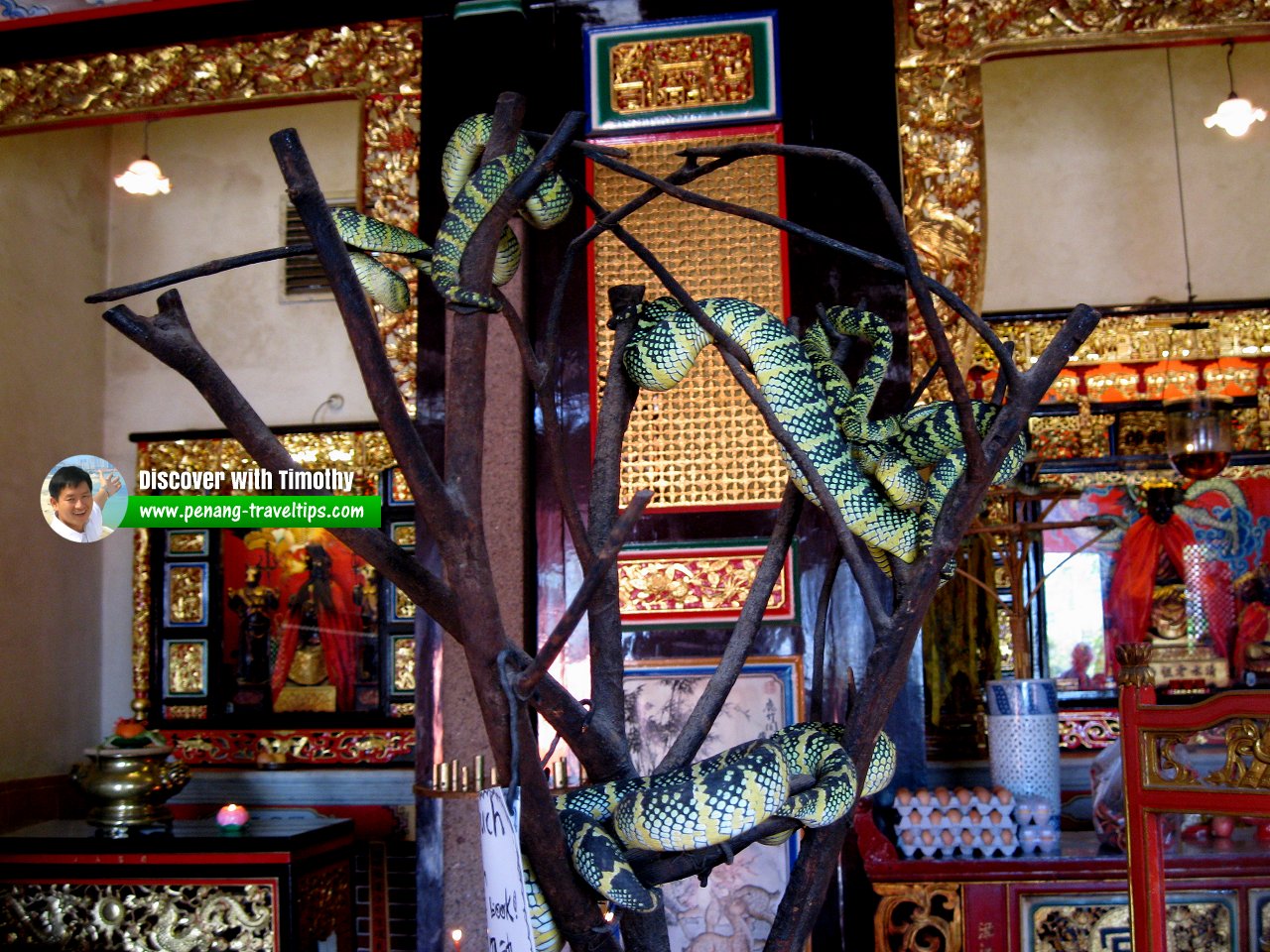 Snakes in the temple (1 March 2009)
Snakes in the temple (1 March 2009)
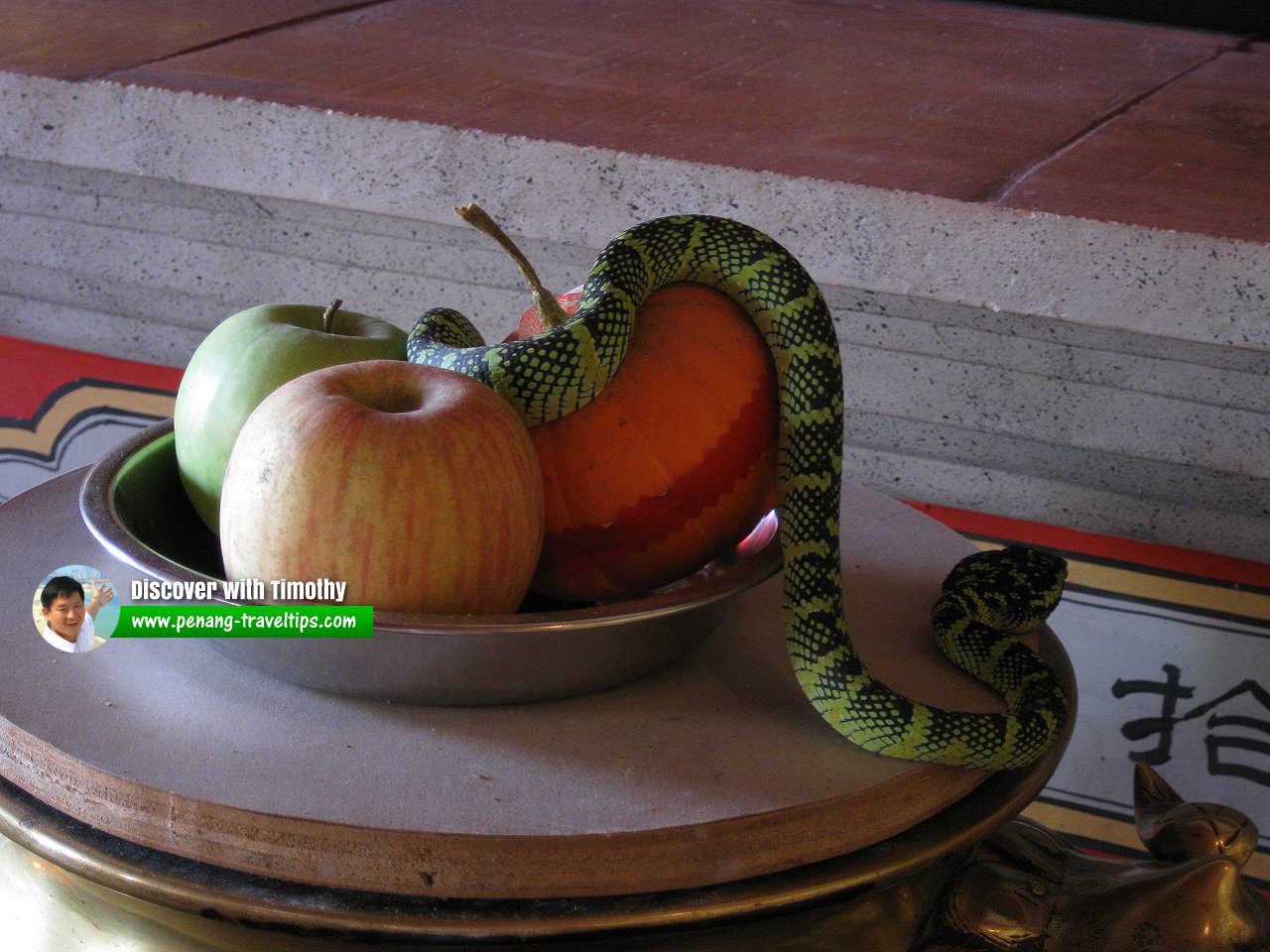 Snake on the offering (1 March 2009)
Snake on the offering (1 March 2009)
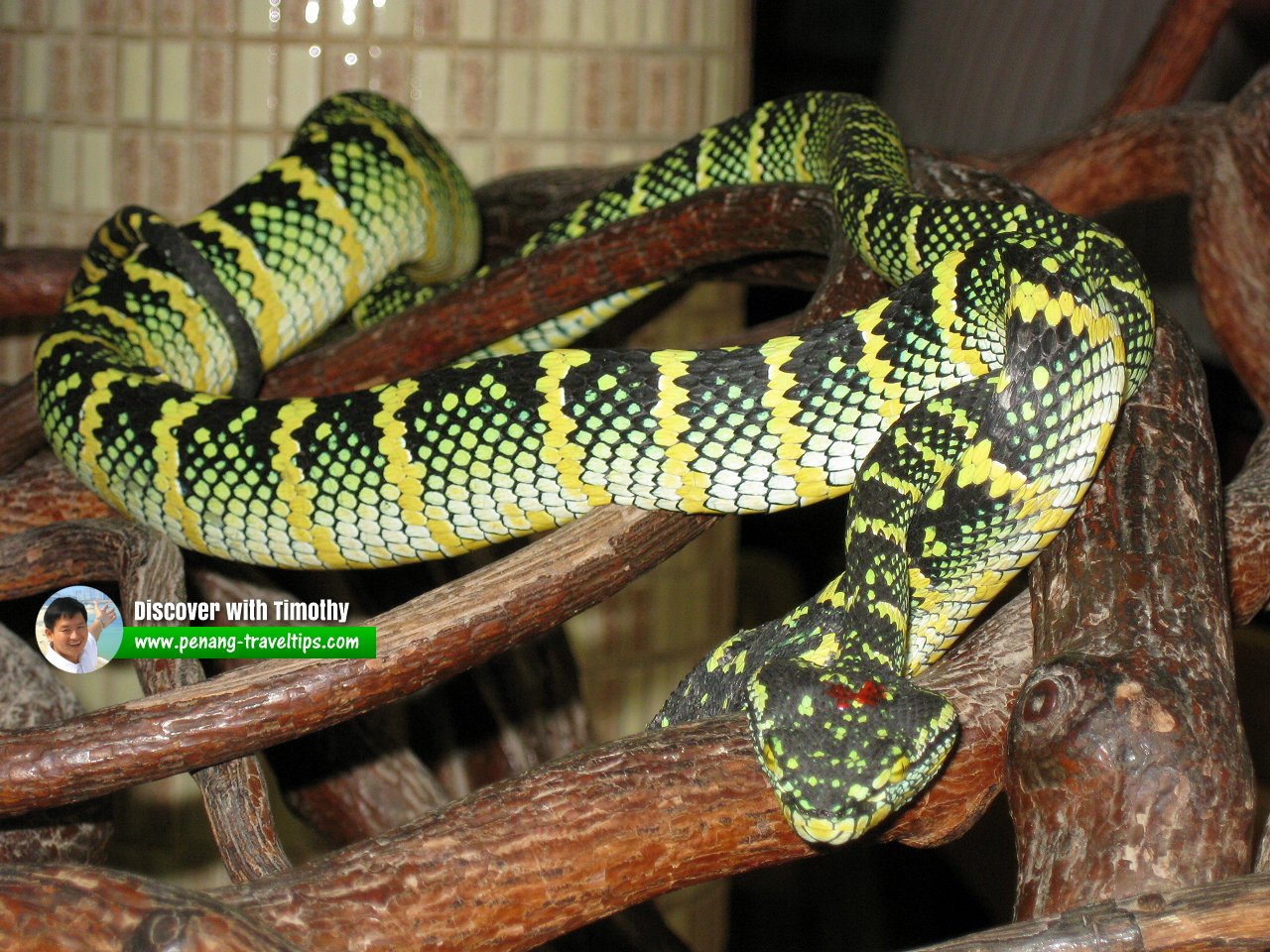 Snake on a branch (1 March 2009)
Snake on a branch (1 March 2009)
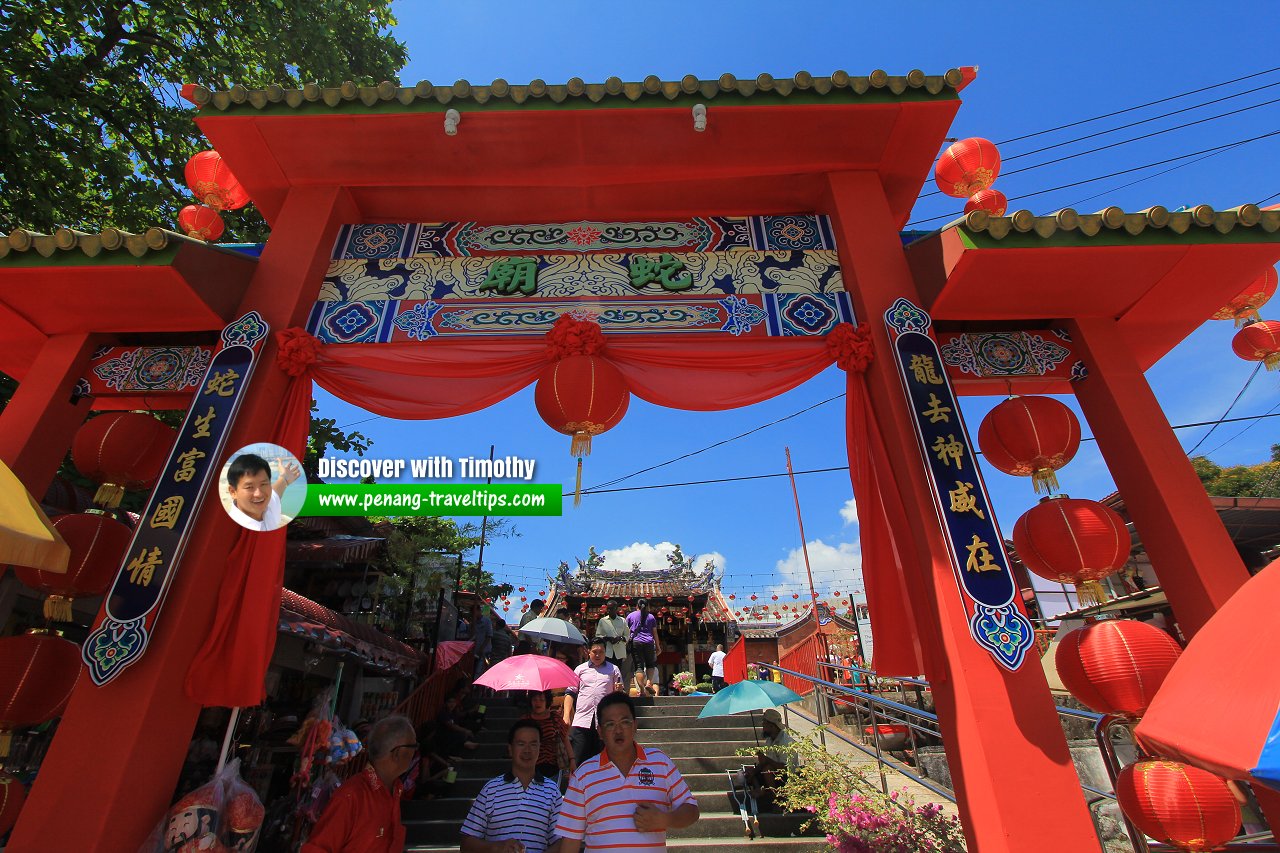 Snake Temple Chinese New Year Arch, celebrating the Year of the Snake 2013 (11 February 2013)
Snake Temple Chinese New Year Arch, celebrating the Year of the Snake 2013 (11 February 2013)
Updates
15 February, 2013 The Bang Kha Lan Snake Temple Chinese New Year Celebration is to start at 5:30 pm today with the arrival of guests.6:00 pm: Chio Tian Culture Drum Performance, speech by organising chairman, celebration chairman, Executive Committee Member for Tourism Danny Law and Penang Chief Minisater Lim Guan Eng. Following the Opening Ceremony, there will be Chinese, Malay, Indian and Western dance performances as well as a Snake show. There is also a Lion Dance at the entrance at 5:30 pm, with Chingay and Stilt Walking.
At the Snake Temple, the Chio Tian Culture Drum Performance will be held at 9:00 pm followed by Snake Dance at 9:30 pm and Silk Ball Throwing at 10:30 pm.
4 January 2013: The Hokkien Kongsi of Penang and the Snake Temple Resident Area Committee are jointly organising the first Snake Festival, to be held on 14 February, 2013, from 8:00 pm to 12:00 midnight, and on 15 February, 2013, from 4:00 pm to 12:00 midnight. The festival will take place within the compound of the Snake Temple, as well as on the slip road in front of the temple.
Getting there
Planning a visit to the Snake Temple? The following guide helps you plan your trip there. It includes a detailed map showing the various sights.By Car
The Snake Temple is located on a sliproad called Jalan Tokong Ular (it was created when the Bayan Lepas main road was straightened). If you're coming from George Town, you need to make a U-turn at the traffic junction of Jalan Mayang Pasir (in front of Dynacraft Industries).
By Bus
The bus stop is on the main road in front of Osram Opto Semiconductors. From the Weld Quay Ferry & Bus Terminal, take Rapid Penang bus 401 that goes to Balik Pulau. Ask a local to help press the bell for you or inform the driver to drop you at the Snake Temple bus stop.
What to see and do
This is not a place for the squirmish. If you expect to see snakes, you will see them. And not just snakes, but poisonous pit vipers. They are much fewer now, but still there they are, coiled on the twigs at the altars. Further down, there is a chamber with trees full of pit vipers. Photographers are on hand to take photos of you with the snakes - that is, with you holding the snakes - if you are game for it. There has not been reports of visitors being bitten, though it's something to approach at your own risk.If you wish to see the Snake Temple with a lot of snakes, do not go during Chinese New Year, particularly during the birthday of Chor Soo Kong, which falls on the 6th day of the New Year celebrations. In order to prevent overtaxing the snakes due to the crowds, noise and smoke, the temple committee removes most of the snakes during this period.
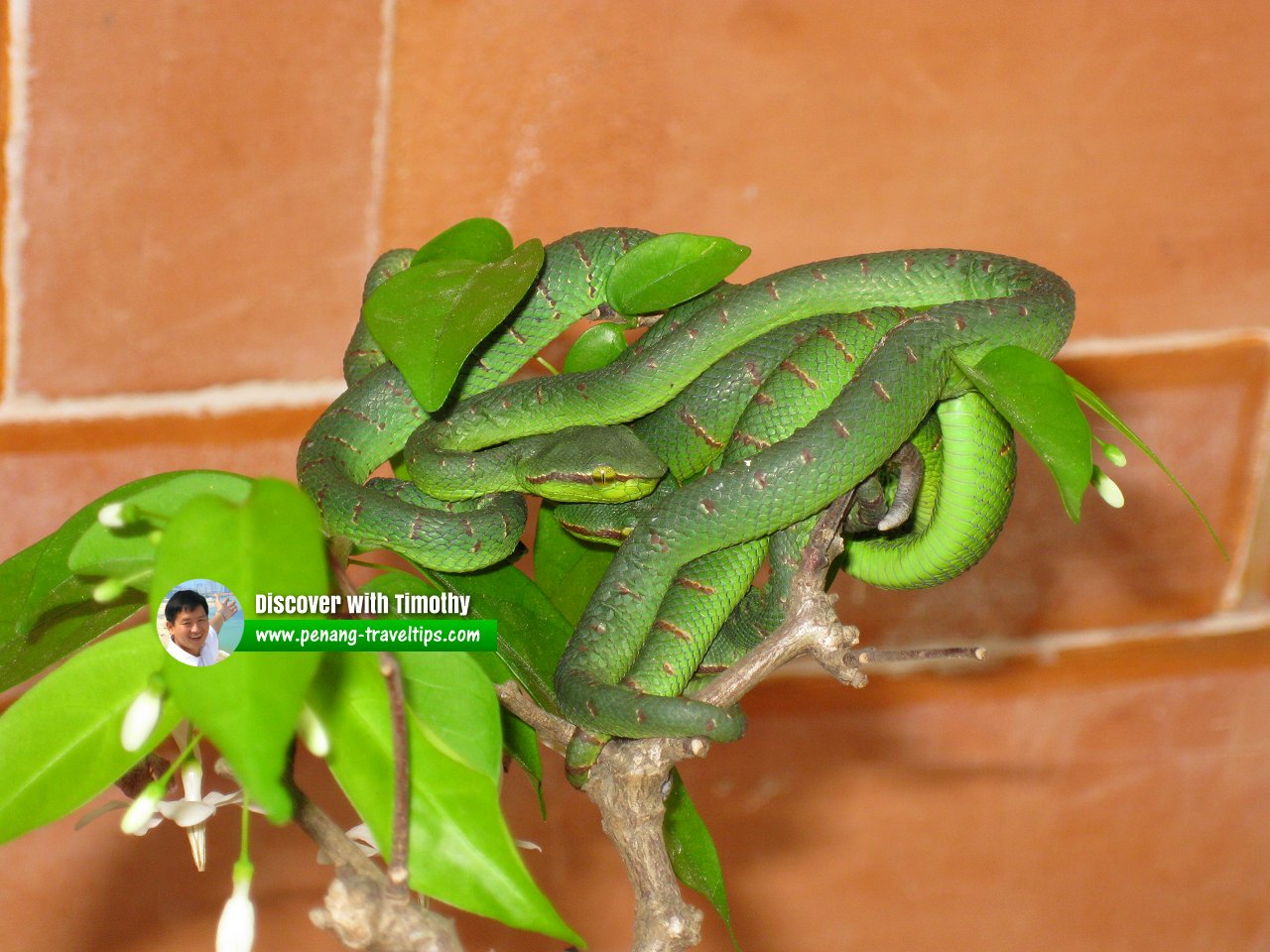 Baby pit vipers at the Snake Temple (1 March 2009)
Baby pit vipers at the Snake Temple (1 March 2009)
Other Chor Soo Kong Temples
The Snake Temple is not the only Chor Soo Kong Temple in Penang. There are at least two other temples in Penang dedicated to the same deity, namely the Batu Maung Chor Soo Kong Temple and another in Balik Pulau. There is also a Chor Soo Kong Temple in Genting Highlands. It was built by the late Tan Sri Dato Seri Dr Lim Goh Tong, the founder of the Genting Group who was an ardent devotee of Chor Soo Kong. Lim was a contractor involved in the construction of the Ayer Itam Dam. During that time, he would regularly patronize the Snake Temple to worship Chor Soo Kong. To build the Chor Soo Kong temple in Genting Highlands, Lim brought the heoh hueh (sacred ash or relic from the altar) from the Snake Temple to dedicate his temple.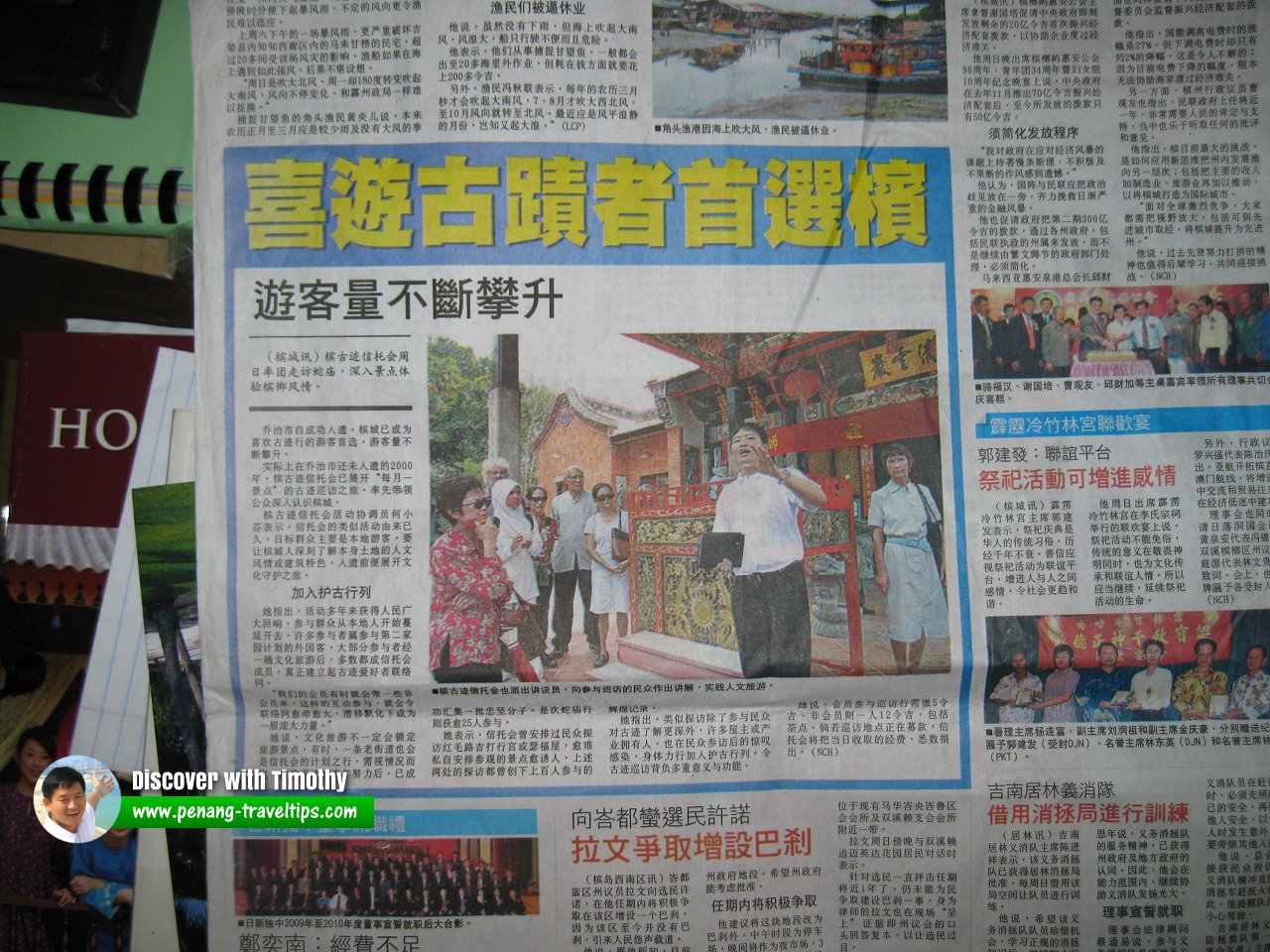 Article in the newspaper about the Penang Heritage Trust Site Visit to the Snake Temple (1 March 2009)
Article in the newspaper about the Penang Heritage Trust Site Visit to the Snake Temple (1 March 2009)
Restoration of the Snake Temple 2008-2009
Since its construction in 1805, the Snake Temple has undergone restorations in 1880, 1907, 1971 and 1980. The Hokkien Kongsi lamented that the last restoration was not properly carried out. It introduced sloppy workmanship and foreign elements that are not congruent with the original craftsmanship of the temple.To return the Snake Temple to its original state, the Hokkien Kongsi embarked on another restoration work to the temple in 2008. During the year-long restoration, the roof ornamentation, which are of broken pottery called chien3nien2 were cleaned and repaired. Damaged figurines were either repaired or replaced. The stucco work and gables were then repainted, as were the roof ridges. Within the temple itself, the gilded pelmets were given a fresh coat of gold leaf as were the filigree screens. During the restoration process, the snakes were moved out of the way, and were only returned to the altars when the temple reopened.
The Snake Temple was reopened in January 2009 in time for the Chinese New Year festivities, as well as for the annual Flame Watching ceremony, which was to take place there at 10:30 pm of 31 January.
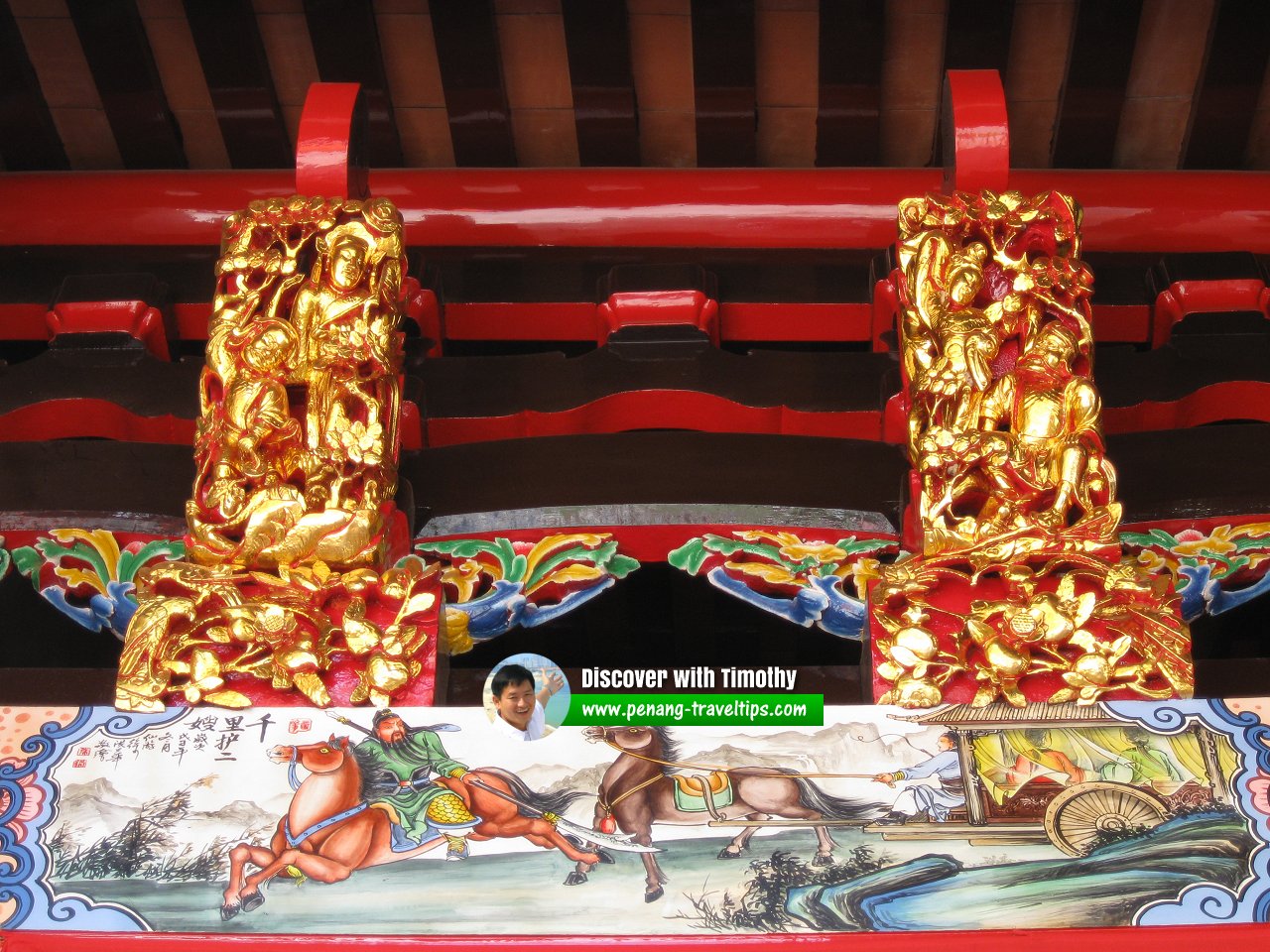 Gilded woodwork and restored murals at the Snake Temple (1 March 2009)
Gilded woodwork and restored murals at the Snake Temple (1 March 2009)
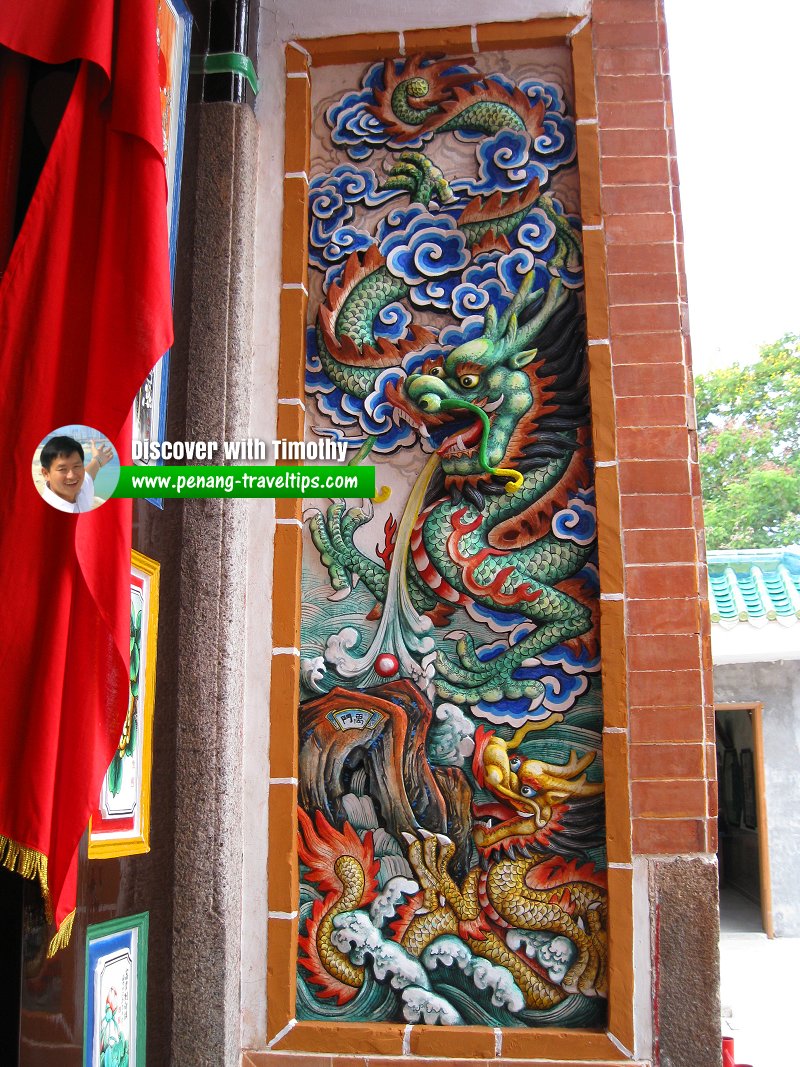 Dragon sculpture, Snake Temple (1 March 2009)
Dragon sculpture, Snake Temple (1 March 2009)
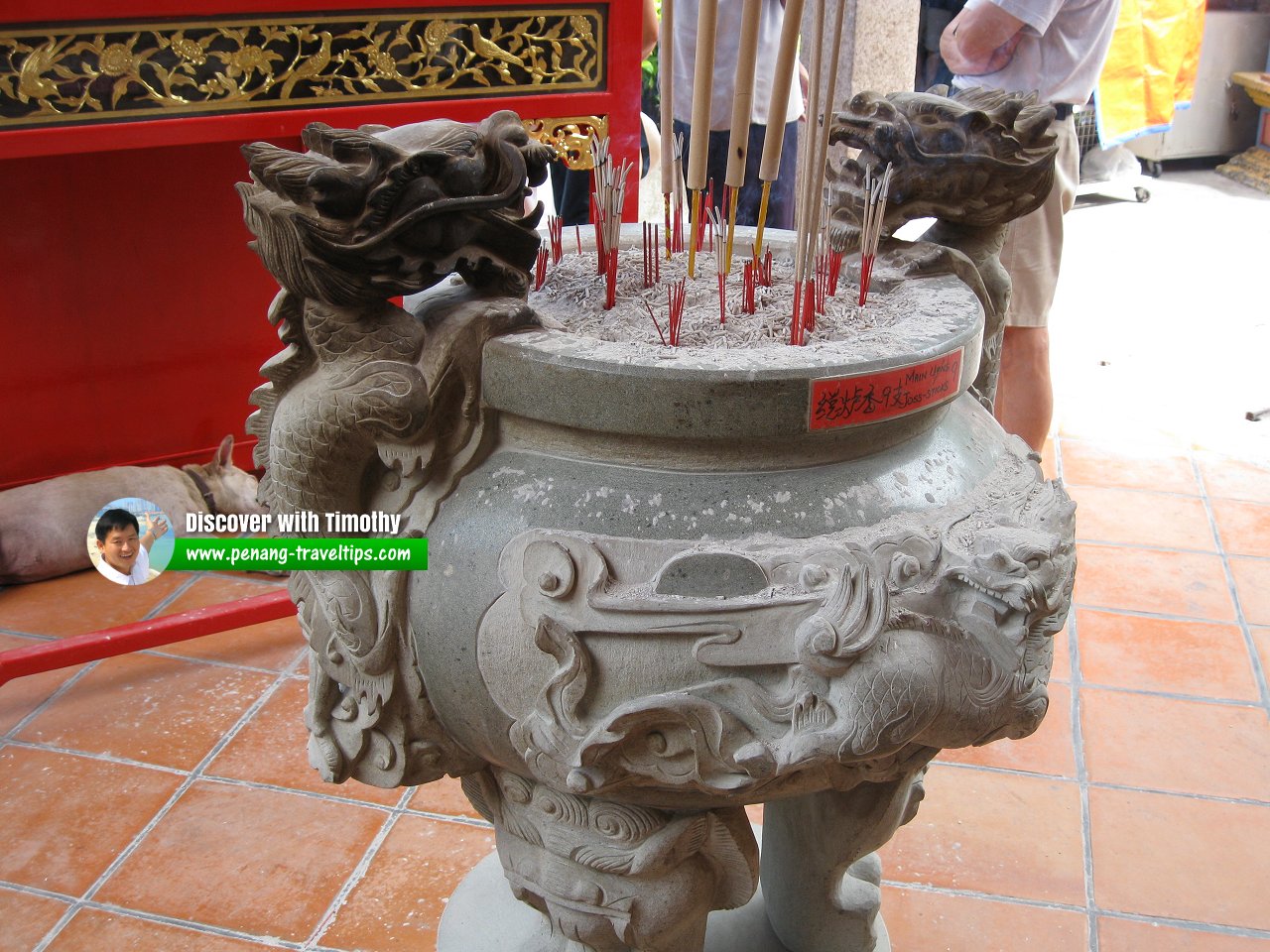 Granite incense burner, Snake Temple (1 March 2009)
Granite incense burner, Snake Temple (1 March 2009)
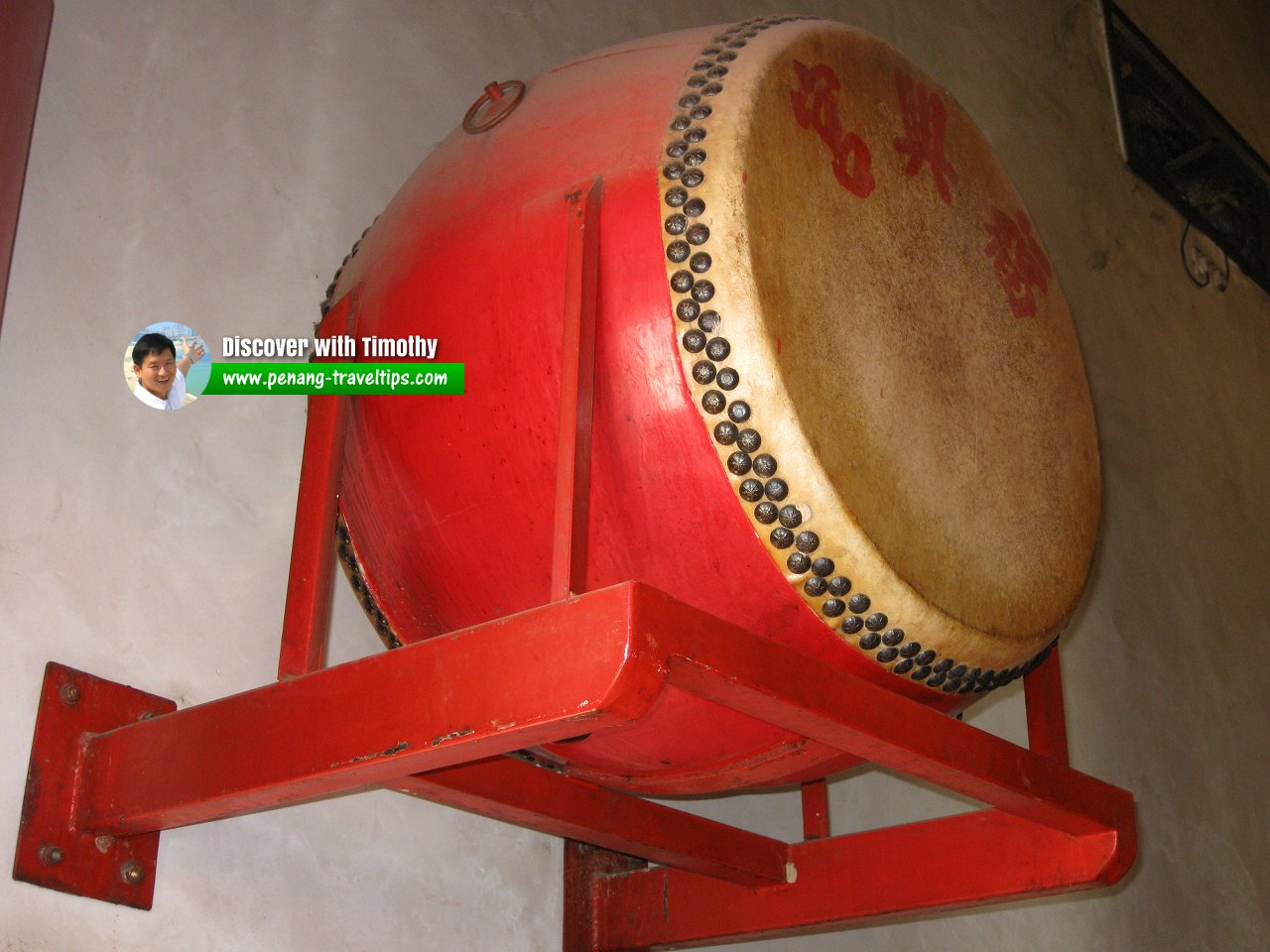 Temple drum, Snake Temple (1 March 2009)
Temple drum, Snake Temple (1 March 2009)
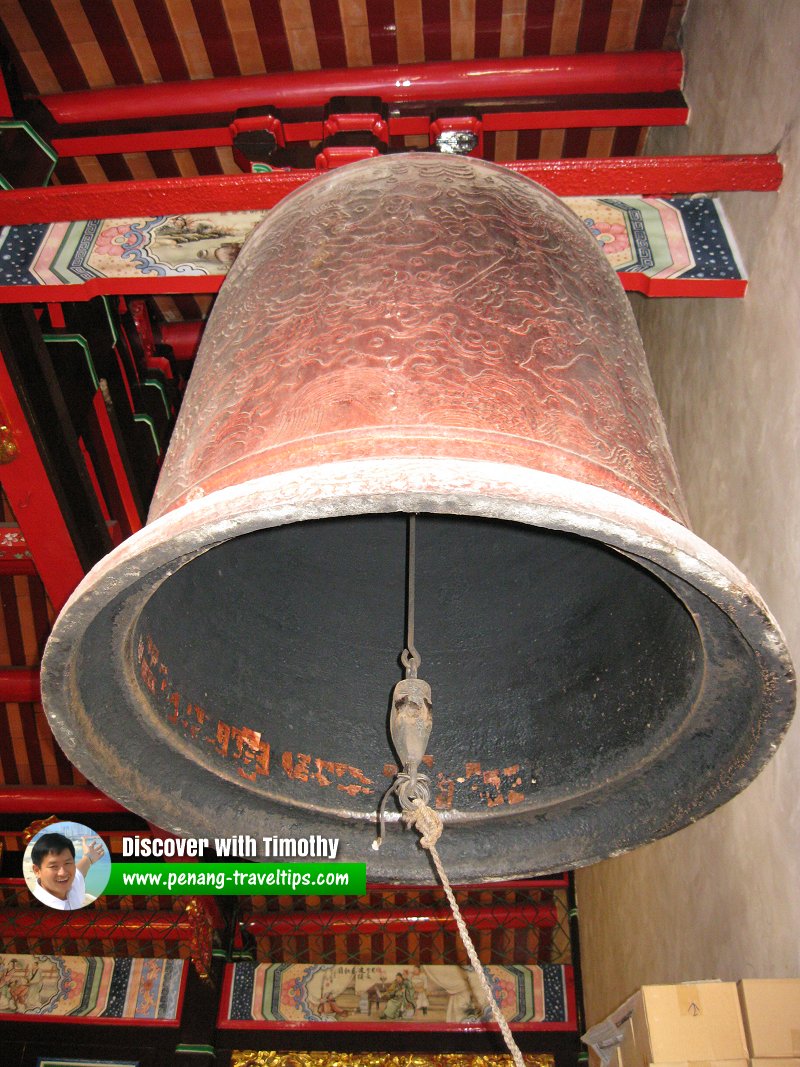 Temple bell, Snake Temple (1 March 2009)
Temple bell, Snake Temple (1 March 2009)
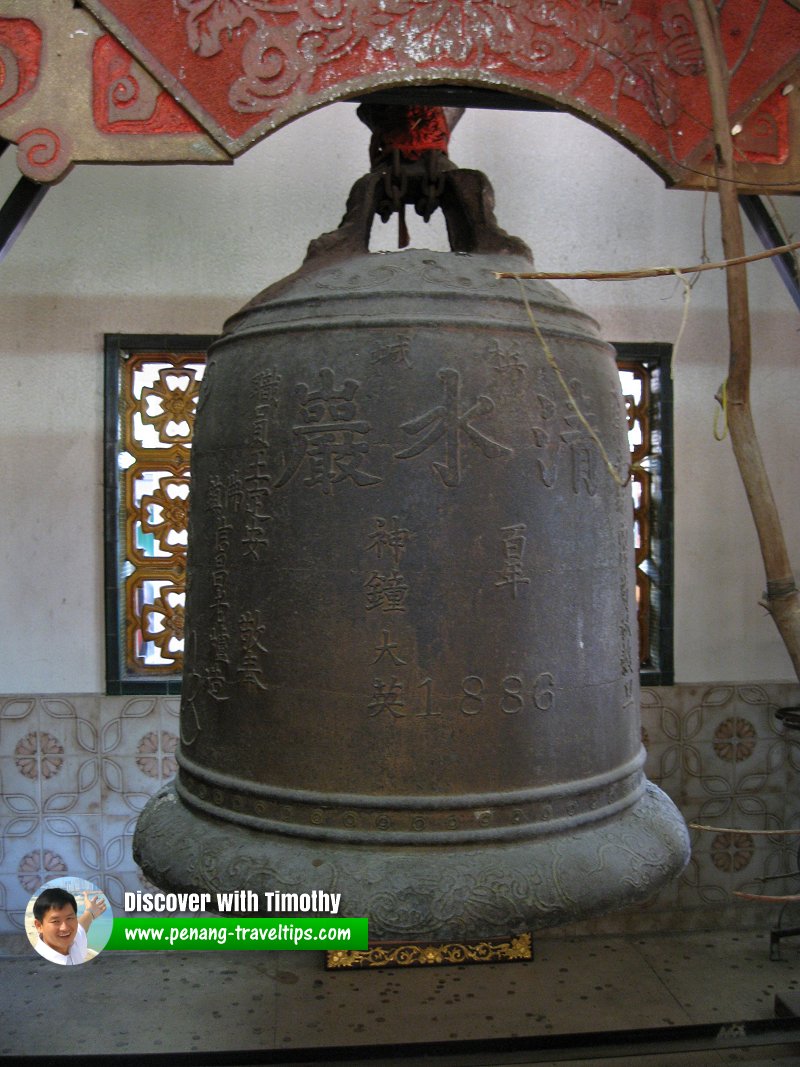 Another temple bell of the Snake Temple with the year 1886 (1 March 2009)
Another temple bell of the Snake Temple with the year 1886 (1 March 2009)
 Door god of the Snake Temple (1 March 2009)
Door god of the Snake Temple (1 March 2009)
Penang Heritage Trust Site Visit
I organised a Penang Heritage Trust Site Visit to the Snake Temple on 1 March, 2009. The committee members of the Hokkien Kongsi headed by its chairman, Dato Lim Eng Soon, were around to welcome us. Among the committee members include Mr Tan Lye Hock of the Tan Kongsi, Mr Khoo Kay Hock of the Khoo Kongsi and Mr Cheah Cheng Ean of the Cheah Kongsi. The Hokkien Kongsi is the umbrella body of the Hokkien clan associations of Penang.Present at this site visit was Dato Anuar Fazal, the Trustee of the Penang Heritage Trust, along with its manager Magdeline Ng and staff Lim Sheau Fung. PHT member Eric Yeoh was tasked to do the report on the visit for our newsletter.
The PHT members were given a briefing by the Hokkien Kongsi committee. Following an opening speech by Dato Lim, Mr Tan Lye Hock provided an explanation about the history and conservation work. Thereafter, PHT members were invited to tea. Then we were given a tour of the Snake Farm.
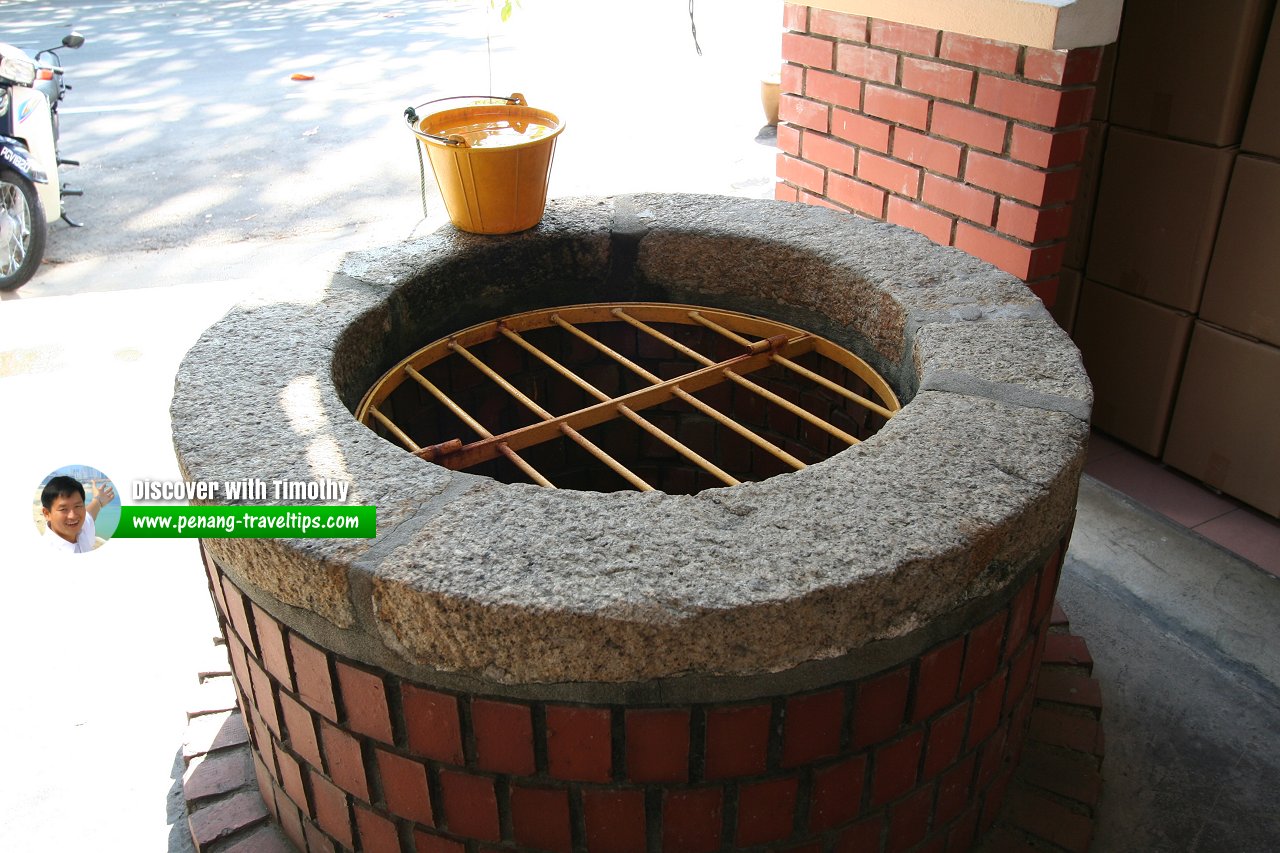 Snake Temple outside well (28 January 2009)
Snake Temple outside well (28 January 2009)
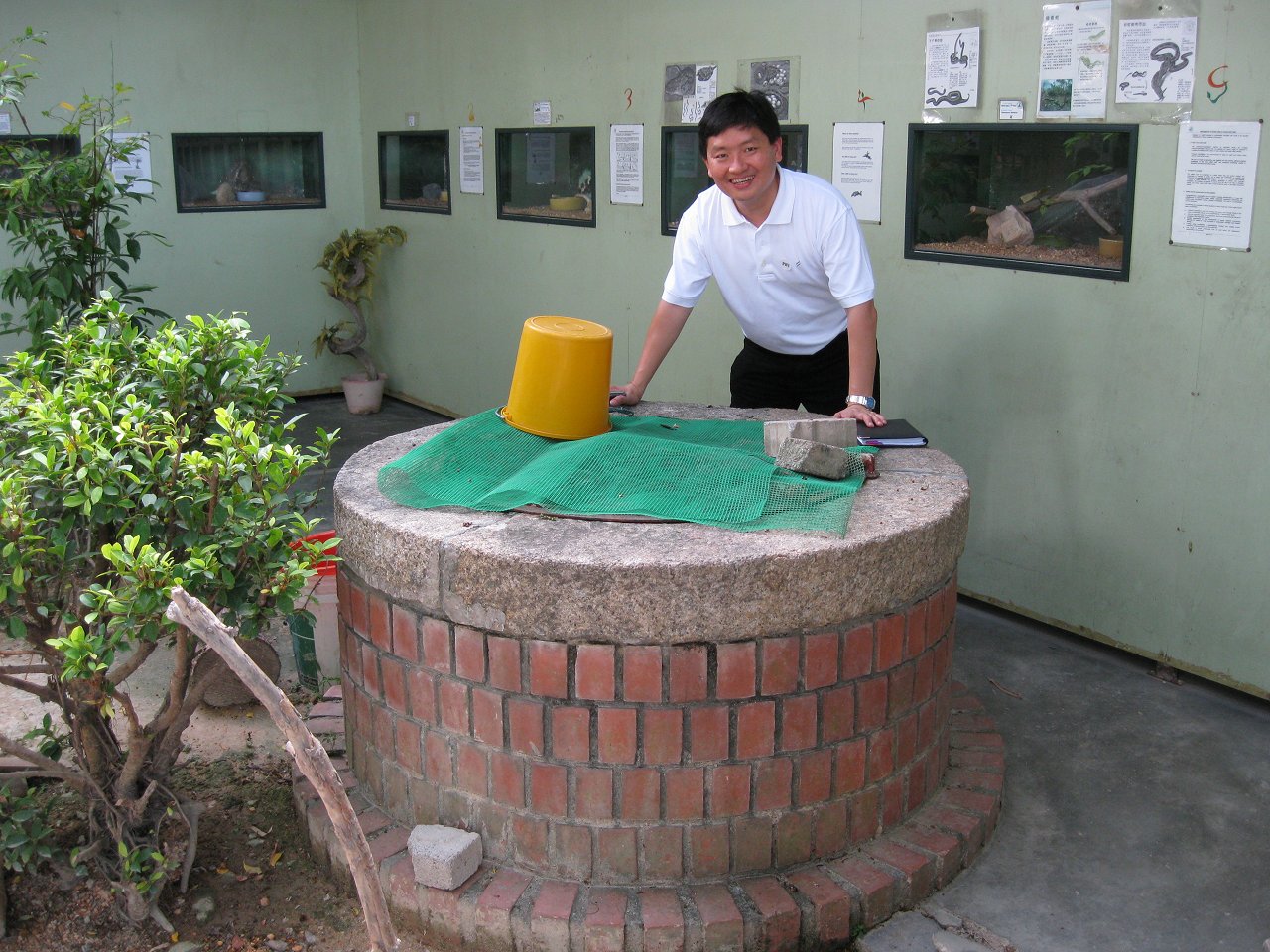 Here I am with the inside well of Snake Temple (1 March 2009)
Here I am with the inside well of Snake Temple (1 March 2009)
Dragon Pure Water Well
Within the Snake Temple are two wells called the two Dragon Pure Water Wells. These ancient wells were dug in 1805, when the Snake Temple was completed. According to legend, the two wells represent the two eyes of a mystical dragon which descended from the heavens during the consecration of the temple. The dragon landed in front of the temple with its tail facing west. The two eyes of the dragon transformed into two wells.One of the wells is 10 feet deep and 3 feet in diameter while another is 10 feet deep and 2 feet in diameter. The well provided fresh water for the surrounding village. According to local belief, those who drank from the well will attain good fortune, health and longevity. One of these two wells is located in front of the Snake Temple, a short distance to the right of the ascending staircase. The other temple is located within the compound of the Snake Farm.
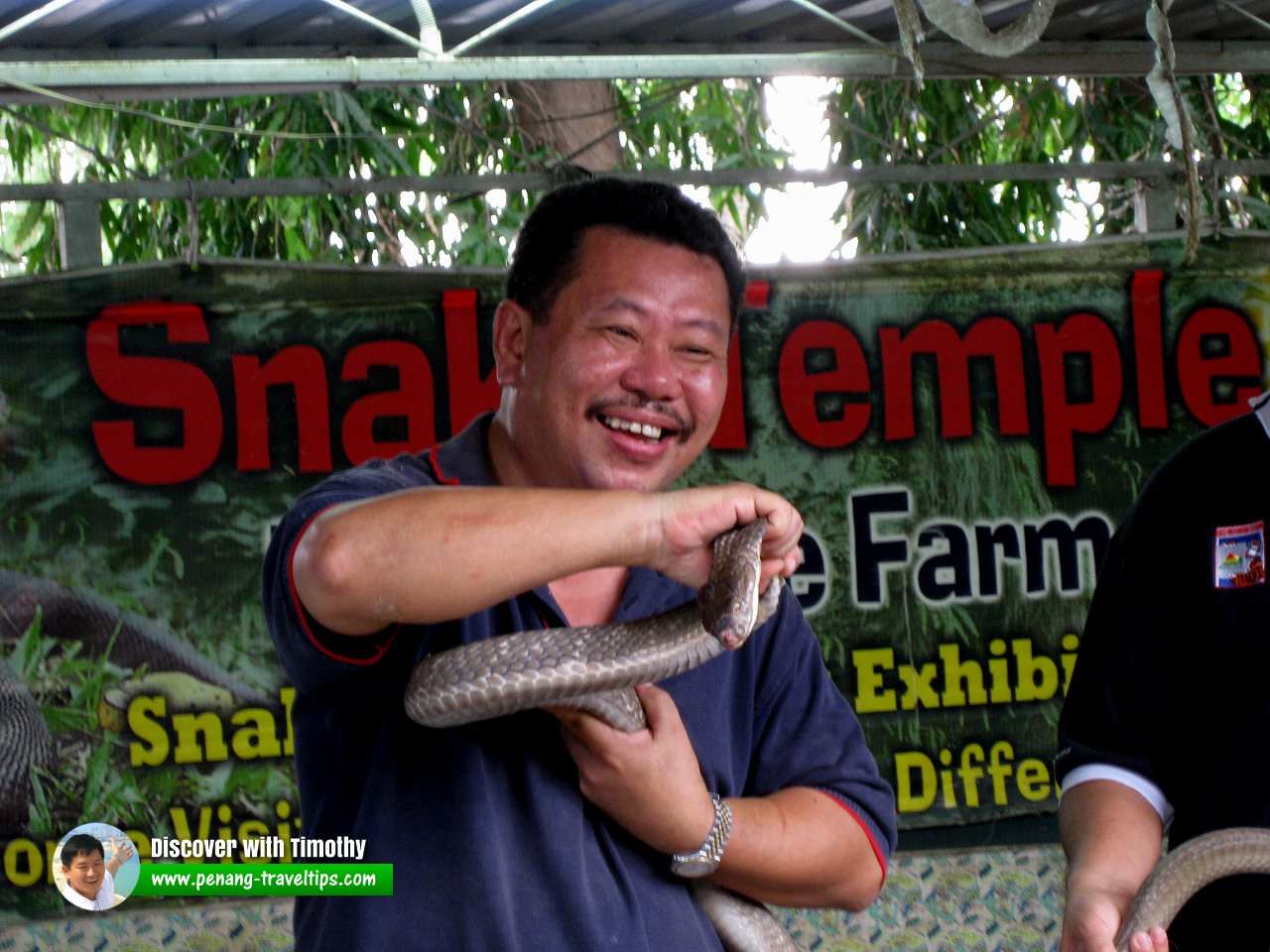 Snake show at the Snake Temple Snake Farm (28 January 2009)
Snake show at the Snake Temple Snake Farm (28 January 2009)
Snake Farm
Within the compound of the Snake Temple is the Snake Farm. It is a reptile farm which was set up by a third party in a deal with the Snake Temple. In exchange for renting the premises, the Snake Farm provides care to the snakes of the Snake Temple. Click here to learn more about the Snake Farm.Snake Temple Photo Galleries
There is so much to show at the Snake Temple that a whole section is devoted to various aspect of the temple.Snake Temple Pit Vipers
Photos of the famous Wagler's Pit Vipers that are found in all the nooks and crannies of the Snake Temple.Snake Temple Dragon Eye Wells
Two wells within the Snake Temple, said to be the eyes of a celestial dragon.Snake Temple Bells
Two giant brass bells within the Snake Temple dating from 1886.Snake Farm
The Snake Farm that was there when I visited in 2009.Batu Maung Chor Soo Kong Temple
Another temple dedicated to the same deity, located in Batu Maung, without slittery residents.References
List of Penang Tourist Attractions

Copyright © 2003-2025 Timothy Tye. All Rights Reserved.

 Go Back
Go Back